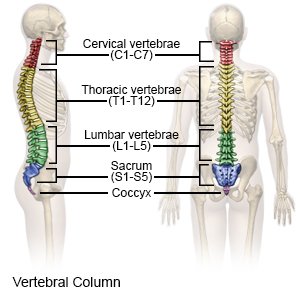Laminectomy
Medically reviewed by Drugs.com. Last updated on Aug 4, 2025.
A laminectomy is surgery to take out the bony arches (lamina) of one or more of the vertebrae in your spine. This surgery can help to relieve pressure on your spinal cord or nerves.
 |
DISCHARGE INSTRUCTIONS:
Call your local emergency number (911 in the US) for any of the following:
- You feel lightheaded, short of breath, and have chest pain.
- You cough up blood.
- You cannot feel or move your legs.
Call your doctor if:
- Your arm or leg feels warm, tender, and painful. It may look swollen and red.
- You cannot control when you urinate or have a bowel movement.
- You see any clear drainage on your skin or bandage that came from your incision.
- There is a bulge in your incision site.
- You have regular headaches.
- Your stitches or staples are swollen, red, or have pus coming from them.
- Your stitches or staples come apart.
- Blood soaks through your bandage.
- Your pain is worse even after you take pain medicine.
- You feel weak, numb, or have pain in your back, buttocks, or legs.
- You have a fever.
- You have questions or concerns about your condition or care.
Medicines:
- Prescription pain medicine may be given. Ask your healthcare provider how to take this medicine safely. Some prescription pain medicines contain acetaminophen. Do not take other medicines that contain acetaminophen without talking to your healthcare provider. Too much acetaminophen may cause liver damage. Prescription pain medicine may cause constipation. Ask your healthcare provider how to prevent or treat constipation.
- Take your medicine as directed. Contact your healthcare provider if you think your medicine is not helping or if you have side effects. Tell your provider if you are allergic to any medicine. Keep a list of the medicines, vitamins, and herbs you take. Include the amounts, and when and why you take them. Bring the list or the pill bottles to follow-up visits. Carry your medicine list with you in case of an emergency.
Activity:
- Rest as needed. You may feel like resting more after surgery. Slowly start to do more each day. Rest when you feel it is needed. For 1 to 2 weeks, limit the times you walk up and down stairs to once a day, if possible. Your surgeon will tell you when it is okay to drive, go back to work, and do your regular activities.
- Do not lift heavy objects for 2 weeks after surgery. Your surgeon will give you specific lifting guidelines. Do not lift anything over your head.
- Follow directions on movements to avoid. In general, do not bend at the hips or twist at the waist. Bend your knees and keep your back straight when you pick something up off the floor.
- Sleep on a firm mattress. When you lie on your back, place 2 or 3 pillows under your knees and the lower part of your legs to raise them. When you lie on your side, bend your knees and use a small pillow under your head and neck. This will decrease the strain on your shoulders, neck and arms. Do not lie on your stomach.
- Do not sit for longer than 15 to 20 minutes at a time. Do this for the first 3 weeks after surgery. Sit in a firm chair with a straight back. Keep your feet on a stool and keep your knees bent and slightly higher than your hips.
- Go to physical or occupational therapy, if directed. A therapist teaches you exercises to make your back muscles stronger and decrease your pain. He or she can also teach you safe ways to bend, lift, sit, and stand.
Self-care:
- Apply heat on your surgery area. Heat helps decrease pain and muscle spasms. Apply heat for 20 to 30 minutes every 2 hours for as many days as directed.
- Carefully wash the wound with soap and water. Dry the area and put on new, clean bandages as directed. Change your bandages when they get wet or dirty.
Follow up with your doctor as directed:
Write down your questions so you remember to ask them during your visits.
© Copyright Merative 2025 Information is for End User's use only and may not be sold, redistributed or otherwise used for commercial purposes.
The above information is an educational aid only. It is not intended as medical advice for individual conditions or treatments. Talk to your doctor, nurse or pharmacist before following any medical regimen to see if it is safe and effective for you.
Further information
Always consult your healthcare provider to ensure the information displayed on this page applies to your personal circumstances.
